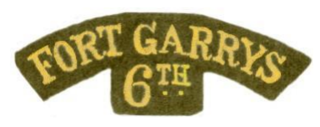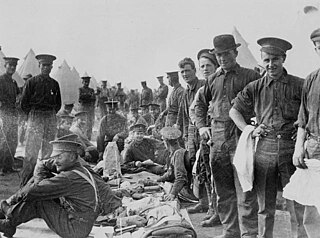Related Research Articles

The North Saskatchewan Regiment is a Primary Reserve infantry regiment of the Canadian Army, headquartered in Saskatoon, Saskatchewan, with companies in Saskatoon and Prince Albert. Its current commanding officer is Lieutenant-Colonel Mike Graver, and the Regimental Sergeant-Major is Chief Warrant Officer Jason Balcaen. The N Sask R is part of the 3rd Canadian Division's 38 Canadian Brigade Group, with the regiment's mission task as of 2024 being to provide direct fire support.

The 12th Manitoba Dragoons is an armoured regiment of the Canadian Army that is currently on the Supplementary Order of Battle.
The 79th Battalion (Manitoba), CEF was an infantry battalion of the Canadian Expeditionary Force during the Great War. The 79th Battalion was authorized on 10 July 1915 and embarked for Britain on 24 April 1916. The battalion provided reinforcements to the Canadian Corps until it was absorbed by the 17th Reserve Battalion, CEF on 12 July 1916. The battalion was subsequently disbanded on 12 October 1917.
The 1st Battalion, Canadian Mounted Rifles, CEF, was an infantry battalion of the Canadian Army. Raised for service during the First World War as part of the Canadian Expeditionary Force (CEF), it was formed in November 1914, in Brandon, Manitoba. Originally a mounted infantry unit named the 1st Regiment, Canadian Mounted Rifles, CEF, which was expanded, following its rerolling and dismounting as an infantry unit, by absorbing other units of the Canadian Mounted Rifles (CMR).

The 5th Battalion, CEF, known as "Tuxford's Dandys," was an infantry battalion of the Canadian Expeditionary Force during the Great War.

The 6th Battalion, CEF was a battalion of the Canadian Expeditionary Force during the First World War.

The 11th Battalion, CEF, an infantry battalion of the Canadian Expeditionary Force, was authorized on 10 August 1914 and embarked for Great Britain on 30 September 1914. It was redesignated as the 11th Reserve Infantry Battalion, CEF, on 29 April 1915, to provide reinforcements to the Canadian Corps in the field. On 4 January 1917, its personnel, along with the personnel of the 100th Battalion, CEF, were absorbed by a new 11th Reserve Battalion (Manitoba), CEF. The battalion was disbanded on 12 October 1917.

The 28th Battalion (Northwest), CEF was an infantry battalion of the Canadian Expeditionary Force during the Great War.
The 32nd Battalion, CEF, was an infantry battalion of the Canadian Expeditionary Force during the Great War.

The 8th Battalion, CEF, also known by the nickname of The Little Black Devils of Canada, was an infantry battalion of the Canadian Expeditionary Force during the Great War. The battalion was authorized on 10 August 1914 and embarked for Great Britain on 1 October 1914. It disembarked in France on 13 February 1915, where it fought as part of the 2nd Canadian Brigade, 1st Canadian Division in France and Flanders until the end of the war. The battalion was disbanded on 15 September 1920.
The 45th Battalion (Manitoba), CEF, was an infantry battalion of the Canadian Expeditionary Force during the Great War.
The 53rd Battalion, CEF, was an infantry battalion of the Canadian Expeditionary Force during the Great War. The 53rd Battalion was authorized on 7 November 1914 and embarked for Great Britain on 29 March 1916. It provided reinforcements for the Canadian Corps in the field until it was disbanded on 12 October 1917.
The 61st Battalion (Winnipeg), CEF was an infantry battalion of the Canadian Expeditionary Force during the Great War. The 61st Battalion was authorized on 20 April 1915 and embarked for Great Britain on 5 April 1915. It provided reinforcements to the Canadian Corps in the field until 6 July 1916, when its personnel were absorbed by the 11th Reserve Battalion, CEF. The battalion was subsequently disbanded on 17 July 1917.
The 68th Battalion (Regina), CEF was an infantry battalion of the Canadian Expeditionary Force during the Great War. The 68th Battalion was authorized on 20 April 1915 and embarked for Britain on 28 April 1916. It provided reinforcements for the Canadian Corps in the field until 6 July 1916, when its personnel were absorbed by the 32nd Reserve Battalion, CEF. The battalion was disbanded on 21 May 1917.

The 90th Battalion, CEF, was an infantry battalion of the Great War Canadian Expeditionary Force. The 90th Battalion was authorized on 22 December 1915 and embarked for Great Britain on 31 May 1916, where on 19 July 1916 its personnel were absorbed by the 11th Reserve Battalion, CEF, to provide reinforcements to the Canadian Corps in the field. The battalion disbanded on 1 September 1917.

The 96th Battalion, CEF, was an infantry battalion of the Great War Canadian Expeditionary Force. The 96th Battalion was authorized on 28 November 1915 and embarked for Britain on 27 September 1916, where its personnel were absorbed by the 92nd Battalion, CEF to provide reinforcements for the Canadian Corps in the field. The battalion disbanded on 8 October 1916.

The 100th Battalion, CEF, was an infantry battalion of the Great War Canadian Expeditionary Force.

The 101st Battalion, CEF, was an infantry battalion of the Great War Canadian Expeditionary Force. The 101st Battalion was authorized on 22 December 1915 and embarked for Great Britain on 29 June 1916, where, on 13 July 1916, its personnel were absorbed by the 17th Reserve Battalion, CEF, to provide reinforcements to the Canadian Corps in the field. The battalion disbanded on 12 October 1917. It was recruited in, and was mobilized at, Winnipeg, Manitoba.
The North Saskatchewan Regiment was a short-lived infantry regiment of the Non-Permanent Active Militia of the Canadian Militia. In 1924, the regiment was reorganized and split up into 4 separate regiments.
The Saskatchewan Mounted Rifles was a cavalry regiment of the Non-Permanent Active Militia of the Canadian Militia. First formed in 1908 as the Saskatchewan Light Horse, the regiment was later redesignated that year as the 22nd Saskatchewan Light Horse and again in 1920 as The Saskatchewan Mounted Rifles. In 1911, the regiment transferred two of its squadrons to the newly formed 29th Light Horse. In 1936, the regiment was amalgamated with the 16th Canadian Light Horse to form the 16th/22nd Saskatchewan Horse.